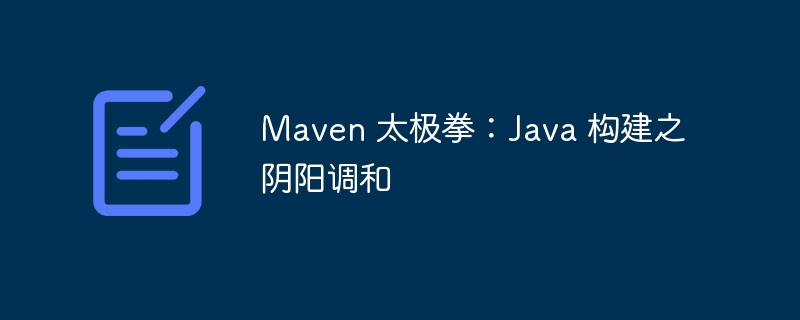Home >Java >javaTutorial >Maven Tai Chi: The Yin and Yang of Java Construction
Maven Tai Chi: The Yin and Yang of Java Construction
- 王林forward
- 2024-03-08 15:55:20718browse

Maven Tai Chi: The Harmony of Yin and Yang in Java Construction In Java development, the build tool Maven is like Tai Chi, achieving project construction and management through the harmony of yin and yang. PHP editor Baicao will deeply discuss the application of Maven in Java projects, analyze its unique features, and lead you to appreciate the mysteries of project construction. Let us explore the essence of Maven together and understand the yin and yang philosophy in Java development.
Maven is an indispensable dependency management artifact in the Java ecosystem. It can help developers easily manage project dependencies and avoid version conflicts and repeated imports. Maven follows the principle of convention over configuration. You only need to add a pom.xml file to the project to complete dependency declaration and build process configuration.
Tai Chi Move 1: Overcoming Strength with Softness—Flexible Dependency Management
The core idea of Maven dependency management is to overcome strength with softness. By centralizing dependency information in pom.xml, developers can easily declare and manage dependencies. Maven will automatically resolve dependencies and download them to the local repository.
<dependency> <groupId>junit</groupId> <artifactId>junit</artifactId> <version>4.13.2</version> <scope>test</scope> </dependency>
Tai Chi Move 2: Mutual Transformation of Form and Meaning—Conversion of Dependence Range
Maven provides a variety of dependency scopes to facilitate developers to flexibly customize dependencies as needed.
- compile: Compile-time dependency, the main dependency used to compile source code.
- test: Depends on testing, only used for testing code.
- runtime: Runtime dependency, used to run compiled code.
- provided: Dependencies are provided by the environment and do not need to be packaged into jar.
<dependency> <groupId>com.Google.guava</groupId> <artifactId>guava</artifactId> <scope>compile</scope> </dependency>
Tai Chi Move Three: Combining Hardness and Softness—Customized Construction Process
The Maven build process is based on conventions, but developers can also customize it as needed. By configuring plugins in pom.xml, various build tasks can be achieved, including:
- Compile: Use Maven Compiler Plugin to compile Java source code.
- Testing: Use Maven Surefire Plugin to execute unit tests.
- Packaging: Use Maven Assembly Plugin to create jar, war or other types of packages.
<plugins> <plugin> <groupId>org.apache.maven.plugins</groupId> <artifactId>maven-compiler-plugin</artifactId> <version>3.8.1</version> <configuration> <source>1.8</source> <target>1.8</target> </configuration> </plugin> </plugins>
Tai Chi Move Four: Combination of Virtual and Real - Dependence on Alias and Inheritance
Maven supports dependency aliases, and you can specify multiple dependency aliases. In addition, Maven also supports dependency inheritance, which can inherit the dependencies of the parent project to the sub-project.
<dependencyManagement> <dependencies> <dependency> <groupId>com.company</groupId> <artifactId>common-dependencies</artifactId> <version>1.0.0</version> <type>pom</type> <scope>import</scope> </dependency> </dependencies> </dependencyManagement>
Tai Chi Ending: Yin and Yang Combined—Maven’s Advantages
Maven has become a Tai Chi master in Java construction with its characteristics of softness and hardness, hardness and softness. It uses dependency management as softness and construction process as rigidity to help developers build Java projects with ease.
Summarize
Just like Tai Chi emphasizes the balance of yin and yang, Maven also pursues the balance between dependency management and build process. By skillfully using techniques such as dependency management, custom builds, and dependency inheritance, developers can unleash the potential of Maven and achieve efficient and flexible Java builds.
The above is the detailed content of Maven Tai Chi: The Yin and Yang of Java Construction. For more information, please follow other related articles on the PHP Chinese website!

